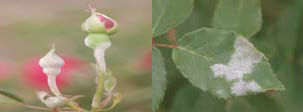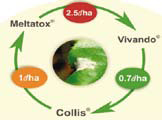
By Joseph Muita
Powdery mildew is caused by a fungus called Sphaerothecapannosa, it is one of the most widespread and easily identifiable plant fungal disease. From vegetable gardens to rose gardens, ornamental trees and shrubs, almost no type of plant is immune even though the fungus is host specific.
What to look for
You’ve likely seen it many times. White or gray powdery spots appear, often times covering most if not the entire leaf surface. It’s also found on plant stems and flowers. Fortunately, the symptoms of powdery mildew are usually worse than the actual damage. Rarely is it fatal to the plant. Advanced stages can cause plant foliage to yellow, curl or turn brown and eventually cause the plant to defoliate prematurely. On flowering plants, the fungus can lead to early bud drop or reduce the flower quality and this kind of loss can be devastating for any grower, large or small.
Epidemiology
In greenhouses, roses and powdery mildew grow continuously. The disease cycle (production of spores, release, germination, infection, and production of conidia) can be as short as 72 to 96 hours. If left uncontrolled, powdery mildew can quickly become epidemic when suitable conditions for disease are present, but especially when rainfall is low or absent, the days are warm and dry, and the nights are cool and damp. Spore maturation, release, spread, infection requires: cool (16°C) + damp (RH – 90 to 99%) night followed by Warm (27°C) + dry (RH – 40 to 70%) days.
Symptoms
 Symptoms first appear on the upper leaf surface. They are irregular, light green to reddish, slightly raised blister like areas shortly followed by the typical dense, powdery white growth (mycelium, conidiophores and spores) of the mildew.
Symptoms first appear on the upper leaf surface. They are irregular, light green to reddish, slightly raised blister like areas shortly followed by the typical dense, powdery white growth (mycelium, conidiophores and spores) of the mildew.
Young leaves become curled or irregularly twisted and are usually covered with enlarged, whitish gray powdery patches of the fungus. Also buds may become infected, initially with the typically flour like symptoms, if this is rubbed off the stems have brown patches but stays firm (this in contrast to botrytis)
Infection Process
Infection starts with spore landing on a leaf (or on the stem or the flower) No water is required for this since the spore consists of 70% water. Germination usually takes place at night in this period the Relative Humidity (RH) is generally higher than during the day. A high RH promotes germination, water drops on the leaves inhibit germination but after drying the leaf is more sensitive to infection. Dispersal takes place mainly by air movement and to a lesser degree by humans or animals. Sporulation takes place usually by day, around noon. The spores’ spread mainly by air movement and to a lesser degree by humans or animals and despite their own high moisture content, the spores do not live long and if they do not germinate on living plant material they may die within 2 or 3 days.
Controlling an existing problem
Powdery mildew is a huge challenge hence the need to explore some ways to keep this fungus from ruining your plants.
First and foremost, prevention is key. As the saying goes, “an ounce of prevention is worth a pound of cure”. Once it is in your environment it is very difficult to eradicate.
Should you find the need to react to an existing condition of powdery mildew, early detection provides the best way to contain and potentially eliminate the problem. There are many commercial products that are effective at containing the spread. However, eliminating an existing problem is not a given.
Most conventional products are made for prevention and control, not elimination of an existing infection. That’s why it’s important to start a control program before powdery mildew occurs or at least at the earliest sign of detection.
Cultural Practices
Getting rid of powdery mildew on roses can at times be a hard task so being proactive and getting out ahead of it through cultural methods like variety selection, providing good air circulation (bending), to avoid excess use of fertilizers, taking away fallen leaves, maintaining a healthy plant, last but not least to shower the leaves so as to kill the spores, but being careful not to raise the RH when you go into the night.
What’s the key?
Judging from the number of questions I get about powdery mildew, I’ve learnt three things over the years; 1.) It’s everywhere, 2.) You dread it, and 3.) You want to know how to get rid of it. So, here is what BASF offers as a perfect solution for Powdery Mildew Control.

The parting shot is that the best way to deal with powdery mildew on roses is to prevent it in the first place.
For more details Contact:
Email: This email address is being protected from spambots. You need JavaScript enabled to view it.; Tel: 0786 856973


